Have you ever wondered about the origins of the cherished Christmas tree tradition? It’s a tradition that has become synonymous with the holiday season, but where did it all begin? Join us on a journey through history as we explore the fascinating origin of the Christmas tree tradition.
Key Takeaways:
- The Christmas tree tradition has roots in pagan practices mentioned in the Hebrew Bible.
- Jeremiah and Isaiah describe cutting down a tree, decorating it with silver and gold, and fastening it upright, similar to modern Christmas tree traditions.
- The Christmas tree tradition predates Christianity and evolved from seasonal, pagan, religious, and national practices.
- The Roman festival of Saturnalia and midwinter celebrations also influenced Christmas customs, including gift-giving and home decoration.
- Santa Claus has evolved from the legend of St. Nicholas, who became the patron saint of children, and Dutch immigrants brought the tradition to America.
The Hebrew Prophets on ‘Christmas Trees’
The concept of decorating trees for festive occasions has ancient roots, dating back to the Hebrew prophets described in the scriptures. The Book of Jeremiah, written around 600 b.c.e., mentions cutting down a tree, adorning it with silver and gold, and fastening it upright. Similarly, the Prophet Isaiah, writing about 150 years earlier, describes the spreading of silver chains on a graven image made from a tree. These references offer intriguing connections to the modern tradition of the Christmas tree.
Jeremiah Scripture: “Learn not the way of the heathen…For the customs of the people are vain: for one cutteth a tree out of the forest, the work of the hands of the workman, with the axe. They deck it with silver and with gold; they fasten it with nails and with hammers, that it move not.” (Jeremiah 10:2-4)
Isaiah Scripture: “He heweth him down cedars, and taketh the cypress and the oak, which he strengtheneth for himself among the trees of the forest: he planteth an ash, and the rain doth nourish it. Then shall it be for a man to burn: for he will take thereof, and warm himself; yea, he kindleth it, and baketh bread; yea, he maketh a god, and worshippeth it, he maketh it a graven image, and falleth down thereto. He burneth part thereof in the fire; with part thereof he eateth flesh; he roasteth roast, and is satisfied: yea, he warmeth himself, and saith, Aha, I am warm, I have seen the fire…And the residue thereof he maketh a god, even his graven image: he falleth down unto it, and worshippeth it, and prayeth unto it, and saith, Deliver me; for thou art my god.” (Isaiah 44:14-17)
These biblical passages not only describe the act of adorning trees but also condemn the pagan practices associated with such rituals. They suggest a shared cultural thread connecting ancient pagan traditions and the modern Christmas tree tradition. While the specific symbolism and meanings may have evolved over time, the foundations of tree decoration can be traced back to the Hebrew prophets’ writings.
Christmas Origins and Customs
While the New Testament does not mention the Christmas tree or provide instructions for celebrating the birth of Jesus, the broader question of Christmas celebrations’ origin is relevant. According to scholars, Christmas customs have evolved from pre-Christian practices and pagan celebrations. Pope Julius I declared December 25 as the date to celebrate the Nativity, linking it to existing midwinter festivities and the winter solstice. Advent, a period of preparation for Jesus’ birth, was recognized by the Church from the fifth century. Over time, Christmas traditions, including the Christmas tree, spread across Europe.
In many cultures, the Christmas tree symbolizes life and renewal. Its evergreen nature represents eternal hope and the cycle of life. Decorating the tree with lights, ornaments, and garlands is a way of bringing light and beauty into the dark winter days. The tradition of bringing an evergreen tree into the home likely evolved from ancient practices of bringing greenery indoors during winter festivals. The use of candles on the tree can be traced back to the German tradition of placing candles on the branches to symbolize the light of Christ.
The Christmas tree has become a central and beloved part of the holiday season in many countries around the world. Families gather together to decorate the tree, often accompanied by festive music and treats. The tree serves as a focal point for gift-giving, with presents placed beneath its branches. It is a symbol of joy, unity, and the spirit of giving that characterizes the Christmas season.
Pagan Midwinter Celebrations: Exploring the Influence of Saturnalia
During the winter solstice, pagan midwinter celebrations took place in various ancient cultures as a way to commemorate the rebirth of the sun and the end of the darkest days of the year. One such celebration was the Roman festival of Saturnalia, which was observed around December 25. Saturnalia was a time of merrymaking, feasting, and gift-giving in honor of the Roman god Saturn.
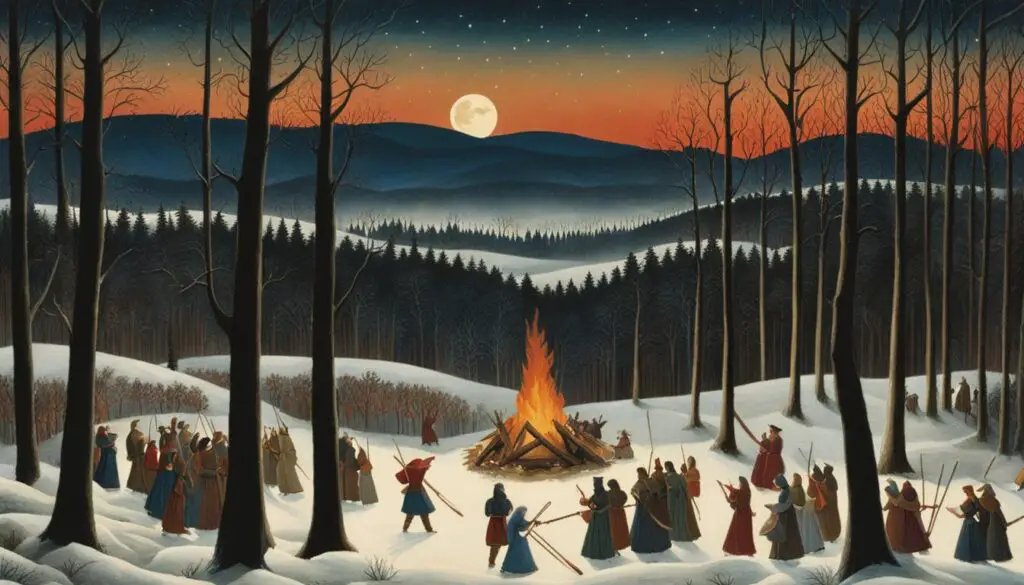
The festival involved various customs, including role reversals where masters served their slaves, homes decorated with evergreen wreaths and branches, and candles being lit to symbolize the return of light. The influence of Saturnalia on Christmas traditions is evident in the practice of gift-giving, exchanging presents, and decorating homes with wreaths and evergreen trees.
“Saturnalia was a time of joy and revelry, with people indulging in feasting, socializing, and gift-giving. It was a celebration that brought people together, regardless of social status, and allowed them to embrace the spirit of generosity and goodwill towards one another.”
By incorporating elements of Saturnalia, Christmas traditions embraced the festive spirit of the season and the values of generosity and togetherness. While the religious significance of Christmas evolved over time, the influence of pagan midwinter celebrations like Saturnalia has undeniably shaped the way we celebrate the holiday today.
The Evolution of Santa Claus
When it comes to the beloved figure associated with Christmas, Santa Claus, his origins can be traced back to the legend of St. Nicholas. St. Nicholas, believed to be the Bishop of Myra in the fourth century, became known as the patron saint of children. In the 12th century, St. Nicholas’s Day was celebrated in France, where small presents were left in children’s shoes. It wasn’t until the Dutch immigrants brought the tradition to America in the 17th century that the character of St. Nicholas started to evolve into the jolly figure we know today as Santa Claus. The modern image of Santa Claus, with his red suit, white beard, and sleigh pulled by reindeer, was popularized by illustrations in the late 19th century.
The story of St. Nicholas and his transformation into Santa Claus is a testament to the power of folklore and cultural adaptation. Over time, the figure of St. Nicholas integrated with various Christmas traditions and took on new characteristics influenced by different cultures and historical events. Today, Santa Claus is a universal symbol of generosity and joy, spreading the magic of Christmas to children and adults alike.
“Santa Claus has a long and fascinating history, evolving from the religious figure of St. Nicholas into the iconic symbol of Christmas we know today. His story is a testament to the enduring power of folklore and the ability of traditions to adapt and change over time.”
The St. Nicholas Tradition
The tradition of St. Nicholas, which eventually led to the modern-day Santa Claus, has deep roots in Christian history and European folklore. St. Nicholas was known for his acts of kindness and generosity, particularly towards children and the less fortunate. His reputation as a gift-giver and protector of children made him a beloved figure in many cultures.
- St. Nicholas was known for secretly giving gifts to those in need, often leaving them in shoes or stockings.
- His feast day, December 6th, is still celebrated in many countries as St. Nicholas Day, with children receiving small gifts and treats.
- The tradition of hanging stockings by the fireplace, which is now synonymous with Santa Claus, is said to have originated from the story of St. Nicholas secretly providing dowries for three impoverished sisters by dropping gold coins down their chimney.
The story of St. Nicholas and his generosity laid the foundation for the magical figure of Santa Claus, who continues to bring joy and excitement to children around the world during the Christmas season.
The Magic of Reindeer and Flying
The connection between reindeer and Christmas is steeped in mythology and symbolism. The myth of flying reindeer has captured the imaginations of people around the world, adding a touch of enchantment to the holiday season.
In many cultures, reindeer hold a special significance. In Siberian shamanic traditions, the indigenous Evenki people revered reindeer as sacred animals. Reindeer provided them with sustenance, clothing, and transportation in the harsh Arctic conditions. The Evenki believed that the reindeer had a deep connection to the spiritual realm, particularly through their consumption of the Fly Agaric mushroom, which grew under evergreen trees.
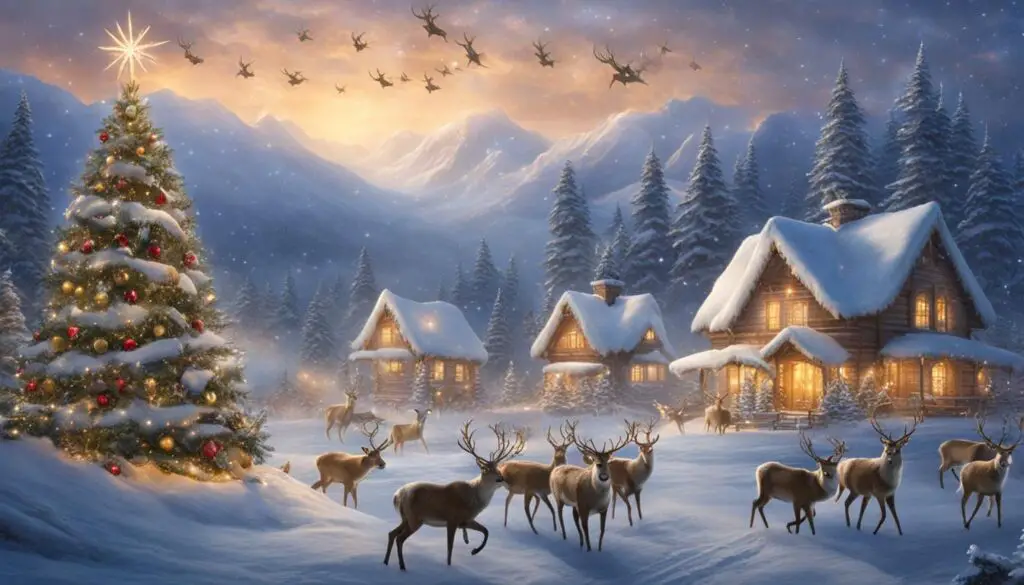
This connection between reindeer and sacred mushrooms may have influenced the mythical concept of flying reindeer associated with Santa Claus. The shamanic practices of the Evenki, including altered states of consciousness and soul flight, may have inspired the belief in the reindeer’s ability to soar through the sky and deliver gifts to children on Christmas Eve.
The symbolism of reindeer and flying represents the transcendence of earthly limitations and the magical possibilities that Christmas brings. It reminds us of the power of imagination, belief, and the joy of the holiday season.
Shamanic Practices and Flight
Shamanism, a spiritual practice that dates back thousands of years, has a rich tradition of journeying into altered states of consciousness and exploring different spiritual realms. Shamanic flight, also known as soul flight or shamanic journeying, is a fundamental aspect of this practice. Shamans believe that they can enter a trance-like state and travel to other dimensions to connect with spirits, receive guidance, and bring healing to their communities.
The concept of shamanic flight is deeply rooted in indigenous cultures around the world. Shamans often use various techniques such as drumming, chanting, or the ingestion of sacred plants to induce an altered state of consciousness. They believe that during these journeys, their souls can leave their bodies and travel to the spirit world or other realms, where they can communicate with spirits, ancestors, and animal guides.
Shamanic flight plays a significant role in the spiritual and cultural traditions of many indigenous peoples. It is a practice that emphasizes the interconnectedness of all beings and the belief that spiritual realms are accessible to those who are open to the experience. The journey itself is considered sacred and is often undertaken with reverence, respect, and a deep understanding of the spiritual power it holds.
The Role of Shamanic Flight in Christmas
Although shamanic flight may not be directly associated with modern Christmas celebrations, its underlying themes of journeying, connecting with spirits, and seeking guidance are reflective of the deeper spiritual meaning of the holiday season. Christmas is a time when people come together to celebrate love, joy, and the renewal of life. It is a time to reflect on the interconnectedness of all living beings and the sacredness of the natural world.
While the specific practices and rituals of shamanic flight may differ from the traditions of Christmas, the essence of both is rooted in a deep spiritual connection to something greater than ourselves. Both traditions invite us to explore the realms beyond the physical, to seek wisdom and guidance, and to embrace the magic and wonder of the unseen.
The Significance of Shamanic Traditions
Shamanic traditions, including the practice of soul flight, hold immense cultural and spiritual significance. They remind us of our connection to the earth, to the spirits, and to one another. These traditions teach us to listen to the wisdom of nature, to honor our ancestors, and to seek balance and harmony in our lives.
As we celebrate Christmas and engage in its various customs and rituals, it can be enlightening to recognize the threads that connect these traditions to the ancient practices of shamanism. In doing so, we can deepen our appreciation for the richness of human spirituality and the profound ways in which it shapes our understanding of the world.
The World Tree and Symbolism
In shamanic cosmology, the concept of the World Tree holds deep symbolic significance. Acting as a gateway between different spiritual realms, the World Tree represents the connection between the lower, middle, and upper worlds. In Siberian culture, the tree that bore the sacred mushrooms, including the Fly Agaric mushroom, also embodied the World Tree. At the top of this mystical tree, the North Star stood as a beacon, marking the highest point of the spiritual realm.
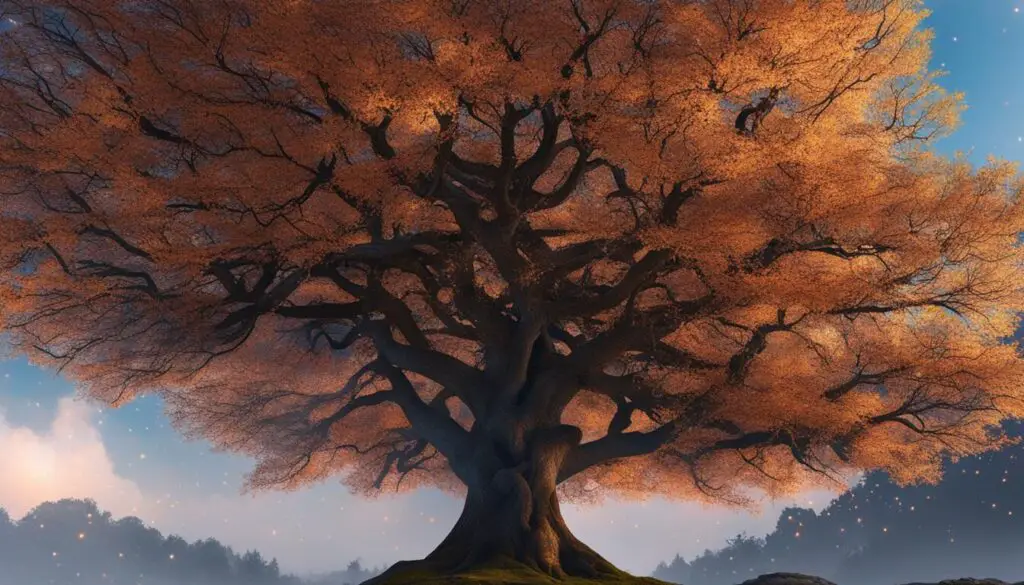
This symbolism offers insights into the tradition of placing a star atop the Christmas tree. The star represents the North Star and the World Tree’s pinnacle, signifying the spiritual heights that Christmas is said to reach. As we gather around our adorned Christmas trees, we can contemplate the interconnectedness of the natural and spiritual worlds.
In shamanic cultures, the World Tree symbolizes unity, balance, and harmony. It reminds us to honor the sacredness of nature and the interconnectedness of all living beings. The Christmas tree, with its roots in ancient pagan and shamanic practices, continues to serve as a reminder of this profound symbolism, inviting us to celebrate the magic and wonder of the holiday season.
Gifting and Celebrating Life
Gifting during the Christmas season holds deep significance, reflecting the rich traditions and spiritual practices of shamanic cultures. In these cultures, the shaman’s journey into the spiritual realm and their return with gifts from the spirits were seen as vital to the community’s survival. The gifts brought back by the shaman were considered a matter of life and death, symbolizing the sacredness and divinity associated with the shamanic practices.
Today, the tradition of gifting during Christmas continues to honor the sacredness of life, survival, and renewal. It serves as a celebration of the spirits and the natural world that sustains us. The act of giving and receiving gifts strengthens the bonds between loved ones and reflects the interconnectedness of all living beings. Just as the shaman’s gifts were seen as essential for the community’s well-being, the exchange of gifts during Christmas symbolizes the importance of generosity and the joy of sharing abundance.
As we celebrate Christmas, let us remember the significance of gifting and embrace the spirit of celebration and gratitude. Through the act of giving, we acknowledge the blessings in our lives and extend kindness and joy to others. Whether it’s a small token of affection or a heartfelt gesture, the act of gifting during Christmas carries a profound message of love, unity, and the celebration of life itself.
The Significance of Gifting during Christmas:
- Symbolizes the sacredness and divinity associated with shamanic practices
- Reflects the interconnectedness of all living beings
- Strengthens bonds between loved ones
- Expresses gratitude and celebration of life
- Embodies the spirit of generosity and sharing abundance
“The act of giving is not solely about the gift itself, but about the love, thoughtfulness, and generosity that accompany it.”
As we exchange gifts with our loved ones, let us cherish the significance of gifting during Christmas and the joy it brings to both the giver and the receiver. It is a meaningful tradition that transcends cultures and has the power to create moments of warmth, connection, and love.
Evolution of Christmas Traditions
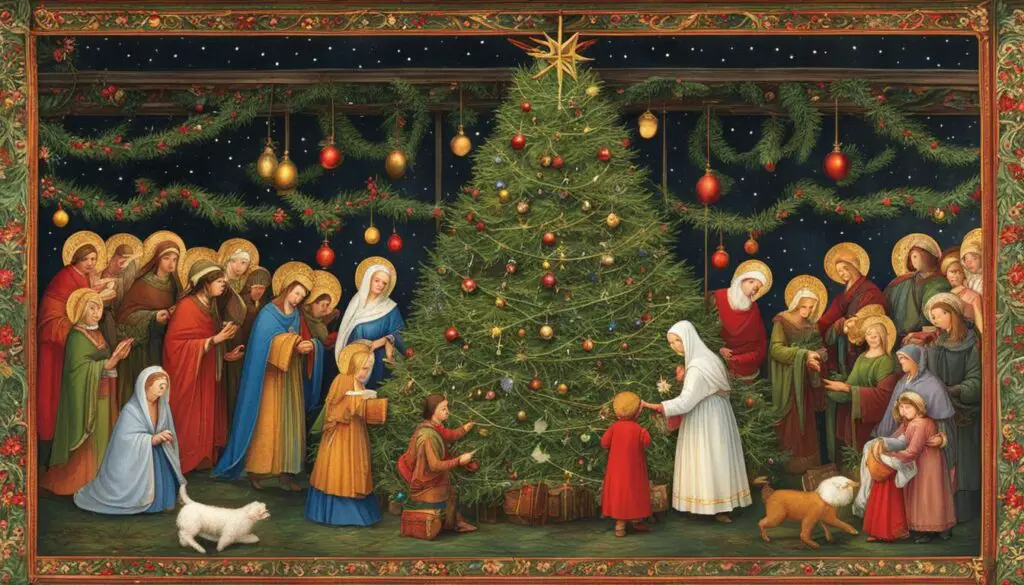
Christmas traditions have a rich history that has evolved over centuries, influenced by various cultures and historical events. From the foods we eat to the customs we follow, the celebration of Christmas has undergone significant changes. Here’s a look at the evolution of some popular Christmas traditions:
1. Christmas Food Traditions
The types of food enjoyed during Christmas have evolved over time. In medieval Europe, feasts featuring roast goose, boar’s head, and mince pies were popular. In the 16th century, turkeys were introduced to Europe, and soon became a favored centerpiece for Christmas feasts. As culinary practices developed, new dishes and desserts emerged. Mince pies, originally made with meat and dried fruit, transformed into sweet treats associated with Christmas. Today, households around the world have their own unique food traditions, from the classic Christmas ham to specialty dishes passed down through generations.
2. Decorating the Christmas Tree
The practice of decorating Christmas trees dates back to the 16th century in Germany. Originally, trees were adorned with fruits, nuts, and sweets. In the 18th century, the tradition spread to other European countries, and glass ornaments and candles were introduced. Over time, the use of electric lights and a wide variety of ornaments became common. Today, Christmas trees are often a centerpiece of holiday decorations, reflecting personal styles and family traditions.
3. Exchanging Gifts
The tradition of exchanging gifts during Christmas has its roots in ancient customs. The Romans celebrated the festival of Saturnalia by giving and receiving presents. In the Christian context, the tradition is associated with the Three Wise Men who brought gifts to the baby Jesus. Over the centuries, the practice of gift-giving has evolved, influenced by cultural and societal changes. Today, exchanging gifts is a way to express love and goodwill, and it has become a cherished part of the holiday season.
Celebration and Renewal
The holiday season brings with it a sense of joy and celebration as people around the world come together to mark Christmas. It is a time to honor traditions, embrace the spirit of giving, and find renewal in the midst of the winter season. Christmas holds a deep significance for many, encompassing both religious and secular aspects, and serving as a reminder of the sacredness of the natural world.
As families and friends gather to exchange gifts, share meals, and create cherished memories, the true meaning of Christmas shines through. It is a time to reflect on the gift of life and the blessings that surround us. The holiday season encourages acts of kindness, love, and generosity, reminding us of the importance of compassion and connection.
Renewal is a central theme of Christmas, as the holiday coincides with the changing of the seasons. The winter solstice, a time when the days begin to lengthen again, symbolizes the hope and promise of new beginnings. From the twinkling lights adorning homes to the beautiful decorations on Christmas trees, the festive atmosphere serves as a reminder to embrace the magic and wonder of the holiday season.
The Significance of Christmas:
- Christmas is a time of celebration, bringing people together to share joy and laughter.
- It serves as a reminder of the sacredness of life and the interconnectedness of all living beings.
- The holiday season encourages acts of kindness, love, and generosity.
- Christmas is a time of renewal, symbolizing the hope and promise of new beginnings.
- It is an opportunity to reflect on the blessings in our lives and express gratitude.
“Christmas is not just a day, but a state of mind.”
As we celebrate Christmas and ring in the new year, let us embrace the true meaning of the holiday season. Let us spread joy, kindness, and love to all those around us, finding renewal in the magic and wonder of this special time. Merry Christmas!
The Historical Significance of Christmas
Christmas is a holiday steeped in history, with traditions and customs that have been passed down through generations. These traditions hold great importance and have had a lasting cultural impact. The historical significance of Christmas lies not only in its religious origins but also in its ability to bring people together and create a sense of joy and celebration.
Throughout history, Christmas has served as a time of reflection, generosity, and togetherness. It has transcended cultural boundaries and become a universal celebration. Over the centuries, Christmas traditions have evolved and adapted, influenced by various cultures and historical events.
“Christmas traditions, with their diverse origins, have become interwoven into the fabric of societies around the world.”
From the ancient Roman festival of Saturnalia to the Christian celebration of Jesus’ birth, Christmas has been shaped by a multitude of influences. It has inspired works of art, literature, and music, and has become deeply ingrained in popular culture. The cultural impact of Christmas is undeniable, as it continues to bring joy and happiness to millions of people each year.
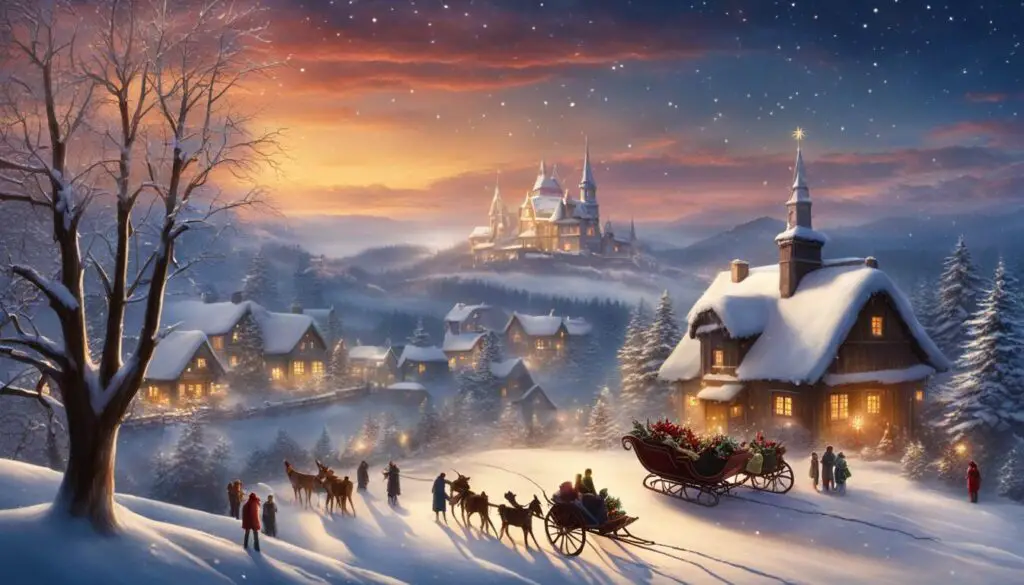
The Magic and Meaning of Christmas
As the holiday season approaches, there is a sense of magic in the air, a feeling of anticipation and wonder. Christmas is a time when traditions come alive, spreading joy and creating lasting memories for families and communities. But beyond the glittering decorations and exchange of gifts, the true essence of Christmas lies in its meaning and the spirit it embodies.
At its core, Christmas is a celebration of love, kindness, and the miracle of life. It is a time to reflect on the blessings we have received and to express gratitude for the people and experiences that have enriched our lives. Christmas reminds us to cherish our loved ones, to reach out to those in need, and to embrace the values of compassion and generosity.
The magic of Christmas can be found in the smiles on children’s faces as they open their presents, in the warmth of gathering around a table filled with delicious food, and in the simple act of spreading joy to others. It is a time when we come together, setting aside our differences and embracing the spirit of unity and togetherness. Christmas touches our hearts, reminding us of the power of love and the importance of connection.
So, as we enter the holiday season, let us carry the magic of Christmas in our hearts. Let us embrace the true meaning of this special time, cherishing the moments with our loved ones, and spreading kindness wherever we go. In a world that can sometimes be filled with darkness, Christmas offers a beacon of hope, reminding us that even in the simplest acts of love and compassion, we can make a difference. Let the magic of Christmas fill your days and may the spirit of this beautiful season bring you joy, peace, and happiness.
FAQ
Which country started the tradition of putting up a Christmas tree?
The tradition of putting up a Christmas tree originated in Germany in the 16th century.
What do the Hebrew prophets say about “Christmas trees”?
The Hebrew prophets, specifically Jeremiah and Isaiah, mention the practice of cutting down a tree, decorating it with silver and gold, and fastening it upright, which bears resemblance to modern Christmas tree traditions. However, these passages in the Bible actually condemn the pagan practices associated with green trees, suggesting that the tradition predates Christianity.
What is the origin and history of Christmas customs?
Christmas customs have evolved from pre-Christian practices and pagan celebrations. Pope Julius I declared December 25 as the date to celebrate the Nativity, linking it to existing midwinter festivities and the winter solstice. Over time, Christmas traditions, including the Christmas tree, spread across Europe, influenced by various cultures and historical events.
What is the connection between Christmas and the Roman festival of Saturnalia?
The ancient Roman festival of Saturnalia, observed around December 25, involved feasting, merrymaking, and gift-giving in honor of the Roman god Saturn. Many Christmas traditions, such as gift-giving, exchanging presents, and decorating homes with wreaths and evergreen trees, can be traced back to Saturnalia.
What is the history and origin of Santa Claus?
Santa Claus has roots in the legend of St. Nicholas, who was thought to be the Bishop of Myra in the fourth century and became the patron saint of children. The tradition of leaving small presents in children’s shoes on St. Nicholas’s Day, celebrated in France in the 12th century, evolved into the figure we know today as Santa Claus. The modern image of Santa Claus was popularized by illustrations in the late 19th century.
What is the connection between reindeer and Christmas?
The connection between reindeer and Christmas can be traced back to the indigenous Evenki people in Siberia, who had a deep connection to nature and practiced shamanism. Reindeer were central to their culture and were known to eat sacred mushrooms found under evergreen trees. This connection may have influenced the mythical concept of flying reindeer associated with Santa Claus.
What are the shamanic practices related to Christmas?
Shamanism, practiced by cultures like the Evenki people, involves altered states of consciousness and soul flight. The shaman would enter different spiritual realms and communicate with spirits through visionary experiences. The use of sacred mushrooms, such as the Fly Agaric mushroom, played a role in these practices, and the belief in the reindeer’s ability to fly may have been inspired by the shaman’s visions and the reindeer’s behavior after consuming the sacred mushrooms.
What is the significance of the World Tree in relation to Christmas?
In shamanic cosmology, the World Tree symbolizes the connection between different spiritual realms, acting as a gateway. The sacred tree that bore the Fly Agaric mushrooms in Siberian culture represented the World Tree, with the North Star positioned at the top symbolizing the highest point of the spiritual realm. This symbolism may explain the tradition of placing a star atop the Christmas tree.
What is the significance of gifting during Christmas?
The tradition of gifting during Christmas reflects the sacredness and divinity associated with shamanic practices and the gifts received from the spiritual realm. In shamanic cultures, the shaman’s journey and return with gifts from the spirit world were seen as a matter of life and death and were crucial for the community’s survival. Christmas, as a celebration of life, survival, and renewal, honors the spirits and the natural world that provides the gift of life.
How have Christmas traditions evolved over time?
Christmas traditions have evolved and changed over centuries, influenced by various cultures and historical events. Turkeys, introduced to Europe in the 1520s, became a popular Christmas feast. Mince pies, originally savory, transformed into sweet treats associated with Christmas. By the end of the 19th century, many of the customs we know today, such as exchanging presents, decorating trees, and enjoying feasts, were established. Modern technologies like radio and television further shaped the way we celebrate Christmas.
What is the significance of Christmas as a time of celebration and renewal?
Christmas is a time of celebration and renewal, encompassing both religious and secular aspects. It is a time to honor traditions, come together with loved ones, and celebrate the joy of life. Christmas serves as a reminder of the sacredness of the natural world and the interconnectedness of all living beings. It is a time to reflect on the gift of life and to find hope and renewal in the holiday season.
What is the historical significance and cultural impact of Christmas?
The historical significance of Christmas lies in its ability to bring people together, bridge cultural divides, and provide a sense of joy and celebration. Christmas traditions, with their diverse origins, have become interwoven into the fabric of societies around the world. The cultural impact of Christmas is significant, as it has influenced art, literature, music, and popular culture. It continues to be a time of reflection, generosity, and togetherness.
What is the magic and meaning of Christmas?
The magic of Christmas lies in the traditions, rituals, and beliefs that have been passed down through generations. It is a time to embrace the joy and wonder of the holiday season, to connect with loved ones, and to express gratitude. Beyond the commercial aspects, the true meaning of Christmas is found in acts of kindness, love, and the celebration of life. It is a time to reflect on the year gone by and to welcome the hope and possibilities of a new year.
